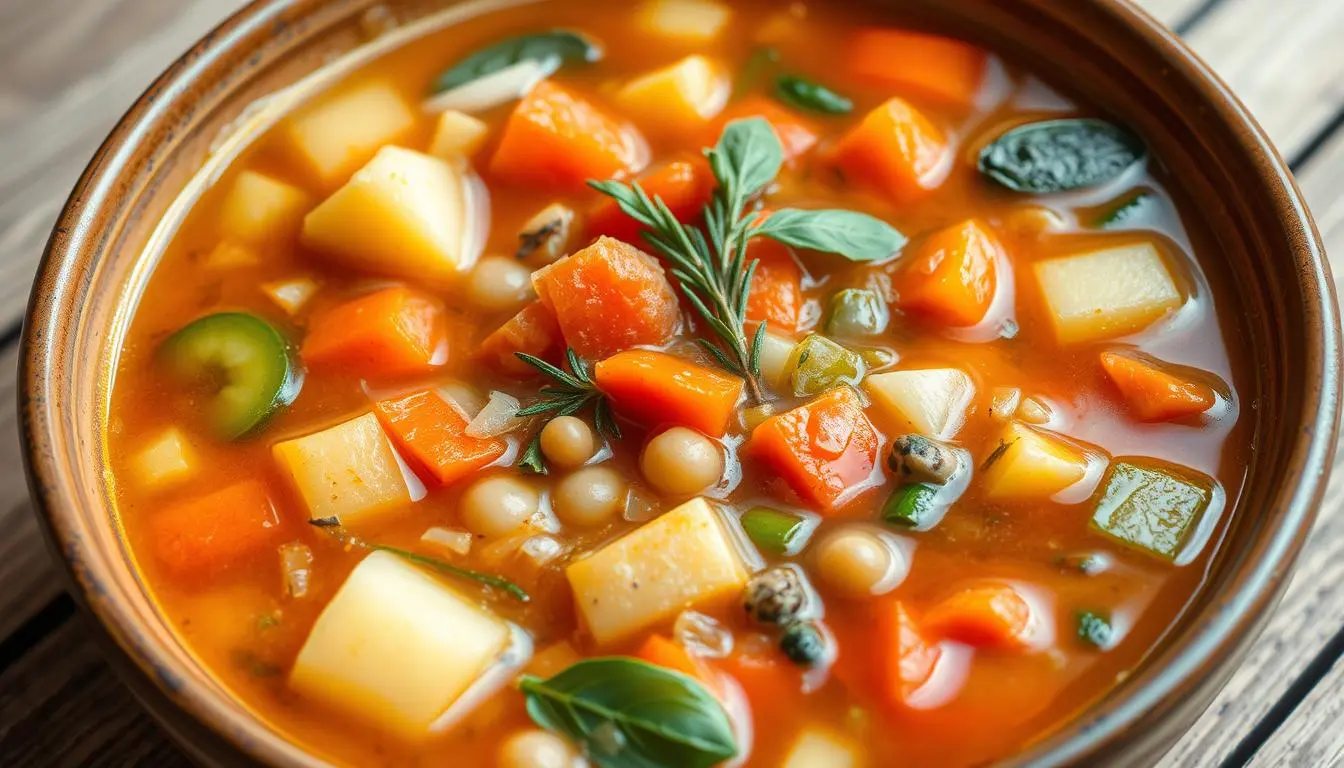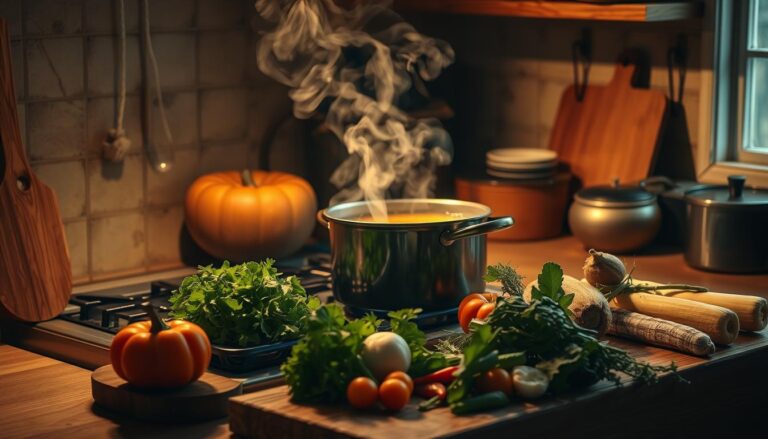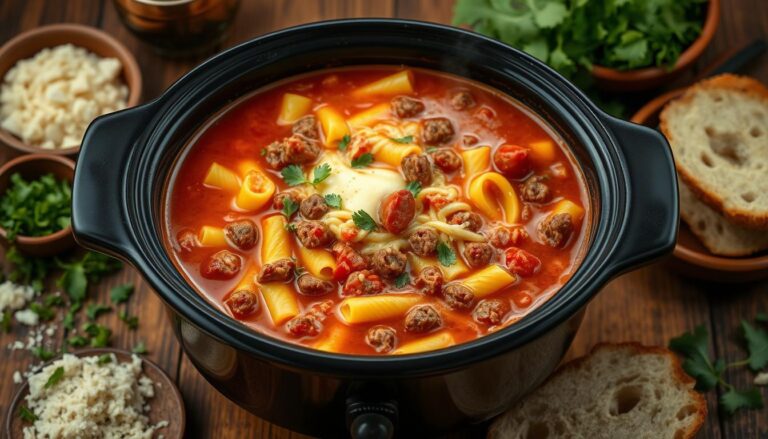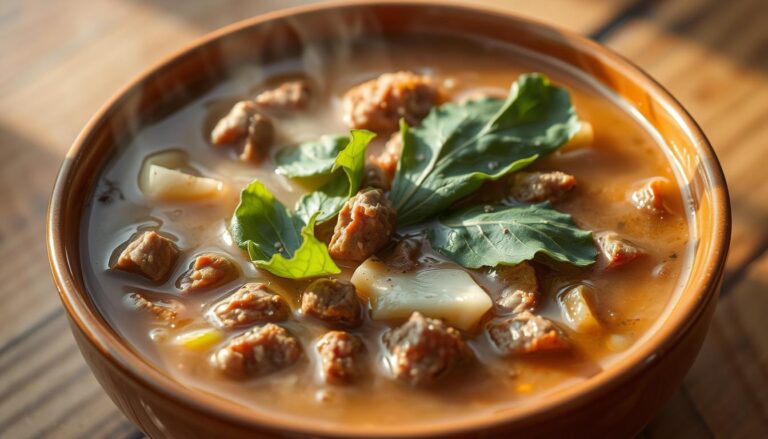Authentic Italian Minestrone Soup Recipe: Step-by-Step Guide
I grew up watching my grandmother chop veggies for her famous minestrone soup. The kitchen would fill with a rich, aromatic blend of herbs and simmering vegetables. It was a sign of comfort and connection.
Today, I’m excited to share an authentic Italian minestrone soup recipe. It’s a celebration of seasonal ingredients and culinary tradition. It turns simple vegetables into a hearty, soul-warming meal.
Each spoonful of this authentic Italian minestrone soup tells a story of generations of Italian home cooks. They knew how to make something extraordinary from everyday ingredients. Whether it’s a cozy winter meal or a light summer dish, this homemade minestrone soup adapts to your needs and tastes.
Table of Contents
Key Takeaways
- Learn an authentic Italian minestrone soup recipe passed down through generations
- Discover how to create a versatile, seasonal vegetable soup
- Understand the importance of fresh, quality ingredients
- Master the art of building layers of flavor in a traditional Italian soup
- Explore a recipe that can be easily adapted to your dietary preferences
Understanding the History and Origins of Minestrone Soup
Minestrone soup has a long history that goes back to ancient Rome. The name “minestrare” means “to serve” in Latin. This soup is more than just food; it shows the heart of Italian cooking.
Minestrone started in the 2nd century B.C. It was a creative dish made with whatever was in season. Necessity became the mother of invention, and families made soups with what they had.
“Minestrone is not just a soup, it’s a story of survival and creativity” – Italian Culinary Historians
The story of minestrone is one of cultural change:
- Before Rome, cooks made simple veggie dishes.
- In the 1500s, tomatoes changed the recipe when they came to Italy.
- Each region made its own version with local ingredients.
Traditional ingredients include:
- Carrots
- Celery
- Onions
- Zucchini
- Borlotti or cannellini beans
Today, minestrone remains a key part of Italian cooking. It shows the importance of home cooking in Italy.
Essential Ingredients for Traditional Italian Minestrone
To make a true Italian vegetable soup, you need the right ingredients. They add depth and richness to your minestrone. Each part is key to the soup’s complex flavor, loved by many.
Fresh Seasonal Vegetables: The Heart of Minestrone
Your Italian vegetable soup comes alive with fresh produce. The classic mix includes:
- Yellow onions (diced)
- Celery stalks
- Carrots
- Green beans or zucchini
- Garlic cloves
- Potatoes
- Fresh spinach or kale
Dried Herbs and Seasonings: Flavor Makers
Enhance your authentic Italian soup with these key seasonings:
- Italian seasoning blend
- Fresh basil
- Rosemary sprig
- Crushed red pepper flakes
- Salt and black pepper
Beans and Pasta: Hearty Additions
Turn your Italian vegetable soup into a filling meal with:
- Kidney beans
- Cannellini beans
- Great Northern beans
- Elbow pasta or ditalini
Each ingredient adds its own texture and taste. Together, they make a dish that warms the soul, true to Italian tradition.
Kitchen Tools and Equipment Needed
Starting an easy minestrone recipe means having the right tools. Your homemade minestrone soup needs specific equipment for great taste. Let’s look at the key tools for making this classic Italian dish.
The first step is choosing the right pot. A large Dutch oven or soup pot (6 quarts or larger) is key for authentic minestrone. This big pot lets ingredients simmer and get rich flavors.
- Large Dutch oven or soup pot (6-quart capacity)
- Sharp chef’s knife for precise vegetable chopping
- Sturdy cutting board
- Wooden spoon for stirring
- Measuring cups and spoons
- Ladle for serving
- Can opener (for beans and tomatoes)
Your knife skills are important for an easy minestrone recipe. A top-notch chef’s knife makes chopping veggies easy and quick. Getting a good knife can really improve your cooking.
Tools like a mandoline slicer and a digital kitchen scale are optional but helpful. They can make your homemade minestrone soup even better.
Pro tip: Always use heavy-bottomed cookware to prevent burning and ensure even heat distribution.
Preparing Your Vegetables for Authentic Italian Minestrone Soup Recipe
Starting an authentic Italian minestrone soup begins with preparing your vegetables. The right cutting and preparation can make your homemade soup stand out.
Choosing and preparing your vegetables is key to a great minestrone soup. You want to cut them into uniform pieces. This ensures they cook evenly and bring out the best flavors.
Proper Cutting Techniques
Learning to cut vegetables well takes time and practice. Here are some tips to improve your soup:
- Use a sharp chef’s knife for clean, precise cuts
- Cut vegetables into uniform 1/2-inch pieces
- Keep your cutting board stable and dry
- Use a rocking motion when chopping to ensure consistency
Size and Shape Guidelines
The right size of vegetables is important for the perfect texture in your soup. Here’s what to aim for:
- Carrots: Dice into 1/2-inch cubes
- Celery: Slice into 1/4-inch thin pieces
- Onions: Chop into small, consistent pieces
- Green beans: Cut into 2-inch segments
Pre-cooking Preparations
Preparing your vegetables before adding them to the soup can make them taste better and feel softer:
- Sauté onions, carrots, and celery to create a flavorful base
- Add garlic last to prevent burning
- Consider blanching harder vegetables like green beans
- Pat wet vegetables dry to prevent unnecessary moisture
Pro tip: Always taste and adjust your vegetable preparation to suit your personal preference in your authentic Italian minestrone soup recipe.
Creating the Perfect Soffritto Base
The foundation of an authentic Italian soup recipe starts with mastering the soffritto. This technique turns simple vegetables into a flavor-packed base for traditional minestrone soup. Think of soffritto as the secret weapon of Italian cuisine that makes your cooking extraordinary.
At its core, soffritto is a blend of onions, carrots, and celery. This trio, known as the Holy Trinity of Italian cooking, adds depth of flavor. It’s key to an authentic Italian soup recipe.
- Use the traditional 2-1-1 ratio: 2 parts onion, 1 part carrot, 1 part celery
- Chop vegetables into uniform small cubes for even cooking
- Select high-quality extra-virgin olive oil for maximum flavor
When preparing soffritto for your traditional minestrone soup, patience is key. Sauté the vegetables gently over medium heat. Let them become tender and slightly golden. Onions add sweetness, celery brings a mild peppery taste, and carrots add gentle sweetness and vibrant color.
Cooking techniques matter. Aim for a gentle 15-20 minute cooking process. Start with high heat for 2 minutes, then reduce to medium-low. The goal is to develop a rich, fragrant base without browning the vegetables. Your soffritto should be translucent and softened, releasing an aroma that promises a delicious soup to come.
“The secret to great Italian cooking lies in the foundation you build with soffritto.” – Italian Cooking Wisdom
Pro tip: You can prepare soffritto ahead of time. It stores well in the refrigerator for 4-5 days or can be frozen for up to 3 months. This makes it a versatile preparation for future culinary adventures.
Mastering the Broth Foundation
Making the perfect broth is key to a great classic Italian minestrone soup. The broth is the heart of the soup, carrying the flavors of all ingredients. Choosing and preparing your broth well can greatly enhance your soup.

Vegetable broth is the top pick for the soup’s base. It lets the fresh vegetable flavors shine while adding depth to the taste.
Vegetable Broth Options
There are a few ways to make a flavorful broth:
- Homemade vegetable stock using fresh produce
- High-quality store-bought vegetable broth
- Chicken stock for non-vegetarian variations
Seasoning and Flavoring Techniques
To add depth to your minestrone, focus on flavor development:
- Sauté aromatics like onions, garlic, and mushrooms
- Use about 6 cups of broth
- Simmer for 20 minutes to enhance flavors
| Broth Type | Flavor Profile | Recommended Use |
|---|---|---|
| Vegetable Broth | Light, Vegetable-Forward | Vegetarian Minestrone |
| Chicken Stock | Rich, Deeper Flavor | Non-Vegetarian Soup |
Professional chefs suggest using a Dutch oven for even heat. This helps in making a broth with more complex flavors. Your aim is to create a broth that enhances the vegetables’ natural sweetness.
Adding Beans and Pasta: Timing and Techniques
Making an authentic Italian minestrone soup needs careful timing for beans and pasta. It’s all about getting the texture and flavor just right.
When you’re making your traditional minestrone soup, each bean cooks differently. Cannellini beans go in early and simmer for 20 minutes to get soft and flavorful. Kidney beans need a good rinse before they go into the soup.
- Cannellini beans: Add at the beginning, simmer 20 minutes
- Kidney beans: Rinse before adding
- Green beans: Include during initial simmering phase
Choosing the right pasta is key for your authentic Italian minestrone soup. Opt for small shapes:
- Ditalini
- Small shells
- Elbow macaroni
For the best texture, add ditalini pasta after 30 minutes of simmering. Cook for another 15 minutes, stirring often to avoid sticking. A pro tip: blend some beans and veggies to make a creamy purée that thickens your soup.
| Ingredient | Cooking Time | Technique |
|---|---|---|
| Cannellini Beans | 20 minutes | Simmer from start |
| Kidney Beans | 20 minutes | Rinse before adding |
| Ditalini Pasta | 15 minutes | Add at 30-minute mark |
By using these methods, you’ll make a tasty, authentic minestrone soup. It will truly capture the spirit of Italian cooking.
Incorporating Fresh Herbs and Greens
To make a real healthy minestrone soup, use fresh herbs and greens. They make your Italian vegetable soup amazing, adding flavor and nutrients.
Fresh herbs are key in Italian cooking. They add great taste and smell to your minestrone, making it better with little work.
Essential Herbs for Authentic Flavor
- Oregano: Provides earthy undertones
- Thyme: Adds subtle herbal notes
- Fresh parsley: Brings bright freshness
- Basil: Introduces sweet, peppery essence
Selecting and Adding Fresh Greens
Picking the right greens makes your minestrone soup stand out. Here are some great choices:
| Green | Flavor Profile | Best Added |
|---|---|---|
| Baby Spinach | Mild, slightly sweet | Last 2-3 minutes of cooking |
| Kale | Robust, slightly bitter | 20-25 minutes before serving |
| Collard Greens | Strong, hearty | 30-40 minutes before serving |
Tip: Add delicate herbs like basil and spinach just before serving. This keeps their flavor and color bright. Thyme and oregano can go in earlier to flavor the broth.
Herb Preservation and Usage
Remember, fresh herbs are great for flavor and looks. Chop them finely and sprinkle on top before serving. This makes them look and taste amazing.
Storage Tips and Leftover Management

Keeping your tasty minestrone soup fresh is easy with the right storage tips. These tips help your soup stay delicious and safe to eat for days.
Here’s how to store your homemade minestrone soup:
- Let the soup cool down to room temperature before storing
- Use clean, airtight glass containers for the fridge
- Put it in the fridge within 2 hours of cooking
Storing your soup in the fridge is simple. It stays great for up to 5 days if stored right. But, the veggies might get softer after 3-4 days.
Freezing your soup makes it last even longer. Here are some tips for freezing:
- Use containers or bags safe for the freezer
- Leave space for the soup to expand
- Mark the container with the date
- Freeze for up to 2-3 months
Tip: For the best taste, don’t add pasta before freezing. Cook fresh pasta when you reheat for better texture.
Reheating your soup is easy. Just heat it on the stovetop on medium, stirring now and then. If it’s too thick, add a bit of water or broth to thin it out.
Serving Suggestions and Pairing Options
Your authentic Italian soup recipe deserves perfect accompaniments. These can make your meal even better. Classic Italian minestrone is more than just a meal. It’s a journey of flavors that invites you to explore.
When serving your classic Italian minestrone, consider these delightful side dishes. They enhance the soup’s rich profile:
- Crusty Bread and Butter: Adds a satisfying crunch and buttery flavor
- Focaccia Bread: Herbaceous and olive-oiled for a traditional touch
- Bruschetta: Introduces tangy tomatoes and fresh basil
- Parmesan Crisps: Provides a crispy, cheesy element
- Caesar Salad: Offers a fresh, creamy contrast
Wine Pairing Recommendations
Your authentic Italian soup recipe pairs beautifully with Italian wines. These wines complement the soup’s robust flavors. They offer nuanced taste profiles that enhance the soup’s complexity.
| Wine Type | Flavor Profile | Best Pairing |
|---|---|---|
| Chianti | Medium-bodied, slightly tannic | Vegetable-rich minestrone |
| Pinot Grigio | Crisp, light | Summer vegetable minestrone |
| Barbera | Fruity, low tannin | Hearty winter minestrone |
Remember, the key to a perfect minestrone experience is balancing flavors. Enjoy the process of creating a traditional Italian meal.
Seasonal Variations and Adaptations
Making an authentic Italian minestrone soup means using fresh ingredients. Your soup can change with the seasons, showing off Italian cooking’s rich traditions.
Choosing the right vegetables is important for a great minestrone. Here are some fun variations to try:
- Summer Minestrone:
- Fresh zucchini
- Yellow squash
- Ripe tomatoes
- Sweet peas
- Winter Minestrone:
- Butternut squash
- Hearty kale
- Root vegetables
- Cabbage
The beauty of Italian minestrone soup is its flexibility. You can adjust it to fit the season and your taste.
Beans are another way to mix things up. Try different beans to keep your soup interesting:
- Cannellini beans
- Kidney beans
- Chickpeas
- Vegetarian protein options
- Turkey sausage for added flavor
Pro tip: Use frozen veggies in winter to keep the soup’s taste and nutrition. A slow cooker is great for easy, comforting meals in cold weather.
Remember, the essence of Italian cooking is about using fresh, available ingredients with love and creativity.
Conclusion
Making an authentic Italian soup like minestrone is more than cooking. It’s about connecting with a rich culinary tradition. This dish lets you turn fresh seasonal ingredients into a nutritious and comforting meal.
Your journey to make the best minestrone soup shows its incredible adaptability. It has a protein-rich base of vegetables and beans. It also fits various dietary needs, making it a perfect mix of flavor, nutrition, and culture. Whether you choose a vegan version or traditional ingredients, there’s something for everyone.
The beauty of an authentic Italian soup recipe is in its simplicity. It respects fresh, local ingredients. By using traditional techniques and seasonal produce, you create a delicious meal. You also join a culinary tradition that has fed generations.
We encourage you to dive into the world of minestrone. Try local ingredients and make it your own. Each pot is a story of tradition, nutrition, and the joy of cooking at home. It’s a true celebration of Italian culinary excellence.







